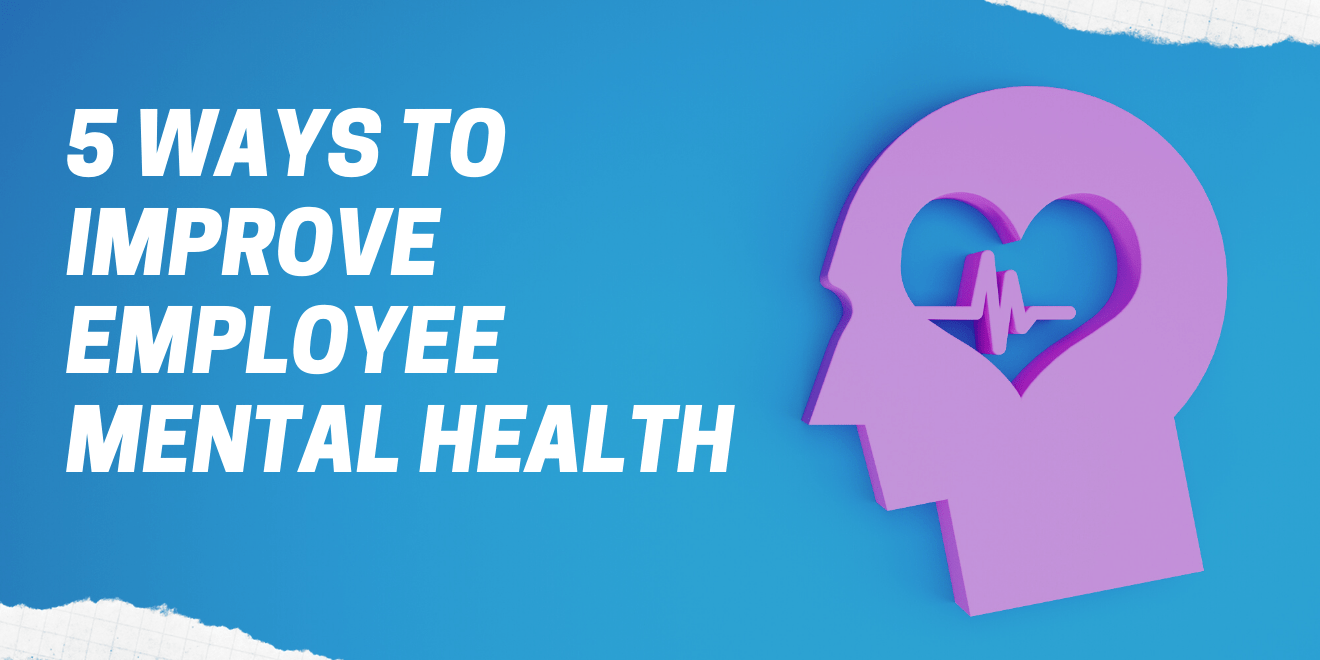5 Ways to Improve Employee Mental Health

Our mental state affects how we think, act, and live our lives, which is why ensuring mental health should be a priority for every single person. While 1 in 5 adults
experience a mental illness, more than half do not receive treatment. If you feel that you are in need of support for your mental health
, reach out, and get the help you need today.
Depression and anxiety are the most prevalent mental illnesses affecting U.S. adults, and together they cost an estimated $1 trillion a year in lost productivity. Most importantly, these disorders significantly harm the individual, with 80 percent of those with depression reporting functional impairment as a result of this mental illness.

With most U.S. adults being in the workforce, employers and businesses have a larger responsibility to promote and prioritize mental health among employees. Proactively addressing mental health can increase productivity and performance while encouraging happier and more satisfied employees. Read on for tips and information on supporting your employees’ mental health in the workplace.
The first step towards promoting mental wellness in the workplace is understanding the causes of the problems you want to avoid, and understanding any employee concerns on this front.
While mental health issues can result from any number of internal and external forces, work makes up a large portion of our daily lives, and certain work environments or circumstances can place employees at risk of increased stress levels and possibly even mental illnesses.
Overly heavy workloads and long hours can mean that employees have little time to rest, and can even burn out if they are stretched too thin for too long.

Negative or poor company culture, insensitive management, and a lack of support and relationships in the workplace can all lead to feelings of social isolation and anxiety.
Not being allowed to participate in making decisions, feeling little control over one’s work, and having unclear tasks and goals can increase discomfort, worry, and can cause feelings of depression.
Concerns about job security can also lead to serious worries and anxiety, while uncomfortable physical environments such as poor lighting, cramped desks, or loud noises can have serious impacts on mental well-being and general feelings of anxiety and depression.
To further understand mental health in your specific workplace, consider asking employees themselves about their worries or concerns regarding their mental health or the company’s handling of mental wellness as a whole. Many may be afraid of addressing their employer about an issue they’re dealing with or may worry about being discriminated against or even fired if they voice that they suffer from a mental health disorder.

To ensure employees’ comfort in answering personal questions or giving potentially critical feedback to management, send out anonymous surveys where they can safely disclose their true thoughts and feelings.
While this action in itself will not solve specific mental health problems, it’s the best step towards understanding and empathizing with employees, and opening a dialogue about mental wellbeing.
Mental health is often considered something that should not be brought up in conversation or actively discussed, especially in professional settings. However, since many people are suffering from mental disorders, the best way to empathize and help is by accepting this as a reality and opening up a discussion about mental health and what we can do to improve or manage it.
As previously mentioned, many individuals suffering from “invisible” mental health disorders may worry about what will happen if they reveal the illness affecting them. They could be concerned about possible discrimination, stereotypes, or being viewed as incompetent, even to the point of being fired.
Thus, as the employer, it’s your job to address the stigma and express your understanding of this existing social phenomenon and employees’ concerns about it. When discussing mental health, choose your words carefully, seek to educate others, and make sure individuals are aware that any health issues they’re facing won’t have an impact on how they’re viewed or treated.

To further foster understanding and improved communication about mental health issues, educate all employees about mental health issues through workshops or seminars. Utilize an outside expert to teach your team how to identify mental health problems in themselves or others, and the right ways to support each other when dealing with mental health issues.
By providing more information about mental health to everyone, you are further opening the dialogue and decreasing the stigma to make employees feel comfortable and understood in their workplace.
While understanding your employees and possible causes of mental health, and opening communication about mental health are great ways to start addressing employee mental health, there are further steps you can take to optimize mental wellbeing for everyone involved.
Mental health has everything to do with the workplace culture. If someone feels excluded, disrespected, or disliked, they are much more likely to face declining mental health.

Create a culture of inclusion by encouraging employees, especially management, to support each other and their subordinates. Make sure managers and supervisors can enforce important company values, and seek to help employees do their best work.
Consider hosting events or opportunities for connection and relationship-building among employees so they can feel more supported and included at work.
Consider hosting events or opportunities for connection and relationship-building among employees so they can feel more supported and included at work.
One of the most important steps you can take to foster better employee mental health is improving manager-employee relations, as only 36 percent of respondents in a Mental Health America survey felt always or often supported by their supervisors.
A lack of support and inclusion is often a precursor to employee mental health issues, so improving these aspects of a manager's relationship with their subordinate can make a big difference.
Whether through a workshop, seminar, or individual training, educating supervisors to be more understanding and aware of their subordinates’ mental health can also contribute to a more positive relationship and better overall mental health.
Working conditions and physical environments can have a tremendous impact on employee well-being. While workplaces may differ, it’s important to create an environment that makes employees feel comfortable and safe.

Make sure work stations have adequate lighting, whether natural or artificial. Designate quiet and social areas so people don’t have to be surrounded by loud noises when they want to focus. Lastly, make sure equipment or work station setup is not causing body discomfort such as neck pain from straining to look at a screen that’s positioned too low.
Unrealistic workload expectations are a common problem for many employees. Feeling overloaded with assignments and like too much is being asked can easily cause significant stress and anxiety.
While productivity and hard work are important, without a healthy mental state none of that can be realized. Prioritize employees’ mental health by finding a balance between a solid workload and enough flexibility and freedom so as not to overwhelm and discourage them.
Often when mental illness is already present, it does not go away without professional treatment and counseling. Thankfully, effective treatment is a game-changer: over 80 percent of employees treated for a mental health issue say their work efficacy and satisfaction have improved.
[caption id="attachment_35143" align="aligncenter" width="920"] Health Check Form Claim History Record Concept[/caption]
Health Check Form Claim History Record Concept[/caption]
To give employees the mental health care and treatment they need, consider offering a health insurance plan that features low out-of-pocket costs for mental health counseling and services. Or, consider implementing an Employee Assistance Program which can offer help to workers dealing with mental health issues at work or home.
Mental health is one of, if not the, most important thing in our lives. It affects every single thing we do, and without adequate support and help when necessary, we cannot be effective employees or human beings.
To further support your employees and their mental well-being, quell any financial worries by simplifying and optimizing your funding with the help of Fundera.
Please include attribution to Fundera.com with this graphic.

Depression and anxiety are the most prevalent mental illnesses affecting U.S. adults, and together they cost an estimated $1 trillion a year in lost productivity. Most importantly, these disorders significantly harm the individual, with 80 percent of those with depression reporting functional impairment as a result of this mental illness.

With most U.S. adults being in the workforce, employers and businesses have a larger responsibility to promote and prioritize mental health among employees. Proactively addressing mental health can increase productivity and performance while encouraging happier and more satisfied employees. Read on for tips and information on supporting your employees’ mental health in the workplace.
Understanding Mental Health in the Workplace
The first step towards promoting mental wellness in the workplace is understanding the causes of the problems you want to avoid, and understanding any employee concerns on this front.
Know the Main Causes
While mental health issues can result from any number of internal and external forces, work makes up a large portion of our daily lives, and certain work environments or circumstances can place employees at risk of increased stress levels and possibly even mental illnesses.
Overly heavy workloads and long hours can mean that employees have little time to rest, and can even burn out if they are stretched too thin for too long.

Negative or poor company culture, insensitive management, and a lack of support and relationships in the workplace can all lead to feelings of social isolation and anxiety.
Not being allowed to participate in making decisions, feeling little control over one’s work, and having unclear tasks and goals can increase discomfort, worry, and can cause feelings of depression.
Concerns about job security can also lead to serious worries and anxiety, while uncomfortable physical environments such as poor lighting, cramped desks, or loud noises can have serious impacts on mental well-being and general feelings of anxiety and depression.
Learn What Employees Think
To further understand mental health in your specific workplace, consider asking employees themselves about their worries or concerns regarding their mental health or the company’s handling of mental wellness as a whole. Many may be afraid of addressing their employer about an issue they’re dealing with or may worry about being discriminated against or even fired if they voice that they suffer from a mental health disorder.

To ensure employees’ comfort in answering personal questions or giving potentially critical feedback to management, send out anonymous surveys where they can safely disclose their true thoughts and feelings.
While this action in itself will not solve specific mental health problems, it’s the best step towards understanding and empathizing with employees, and opening a dialogue about mental wellbeing.
Importance of Open Discussion
Mental health is often considered something that should not be brought up in conversation or actively discussed, especially in professional settings. However, since many people are suffering from mental disorders, the best way to empathize and help is by accepting this as a reality and opening up a discussion about mental health and what we can do to improve or manage it.
Address the Stigma
As previously mentioned, many individuals suffering from “invisible” mental health disorders may worry about what will happen if they reveal the illness affecting them. They could be concerned about possible discrimination, stereotypes, or being viewed as incompetent, even to the point of being fired.
Thus, as the employer, it’s your job to address the stigma and express your understanding of this existing social phenomenon and employees’ concerns about it. When discussing mental health, choose your words carefully, seek to educate others, and make sure individuals are aware that any health issues they’re facing won’t have an impact on how they’re viewed or treated.

Host Workshops and Seminars
To further foster understanding and improved communication about mental health issues, educate all employees about mental health issues through workshops or seminars. Utilize an outside expert to teach your team how to identify mental health problems in themselves or others, and the right ways to support each other when dealing with mental health issues.
By providing more information about mental health to everyone, you are further opening the dialogue and decreasing the stigma to make employees feel comfortable and understood in their workplace.
How to Support Workplace Wellness
While understanding your employees and possible causes of mental health, and opening communication about mental health are great ways to start addressing employee mental health, there are further steps you can take to optimize mental wellbeing for everyone involved.
1. Foster a Company Culture of Respect and Inclusion
Mental health has everything to do with the workplace culture. If someone feels excluded, disrespected, or disliked, they are much more likely to face declining mental health.

Create a culture of inclusion by encouraging employees, especially management, to support each other and their subordinates. Make sure managers and supervisors can enforce important company values, and seek to help employees do their best work.
Consider hosting events or opportunities for connection and relationship-building among employees so they can feel more supported and included at work.
Consider hosting events or opportunities for connection and relationship-building among employees so they can feel more supported and included at work.
2. Train Supervisors and Managers
One of the most important steps you can take to foster better employee mental health is improving manager-employee relations, as only 36 percent of respondents in a Mental Health America survey felt always or often supported by their supervisors.
A lack of support and inclusion is often a precursor to employee mental health issues, so improving these aspects of a manager's relationship with their subordinate can make a big difference.
Whether through a workshop, seminar, or individual training, educating supervisors to be more understanding and aware of their subordinates’ mental health can also contribute to a more positive relationship and better overall mental health.
3. Build a Productive Atmosphere
Working conditions and physical environments can have a tremendous impact on employee well-being. While workplaces may differ, it’s important to create an environment that makes employees feel comfortable and safe.

Make sure work stations have adequate lighting, whether natural or artificial. Designate quiet and social areas so people don’t have to be surrounded by loud noises when they want to focus. Lastly, make sure equipment or work station setup is not causing body discomfort such as neck pain from straining to look at a screen that’s positioned too low.
4. Consider Workloads and Expectations
Unrealistic workload expectations are a common problem for many employees. Feeling overloaded with assignments and like too much is being asked can easily cause significant stress and anxiety.
While productivity and hard work are important, without a healthy mental state none of that can be realized. Prioritize employees’ mental health by finding a balance between a solid workload and enough flexibility and freedom so as not to overwhelm and discourage them.
5. Provide Quality Health Insurance and Counseling
Often when mental illness is already present, it does not go away without professional treatment and counseling. Thankfully, effective treatment is a game-changer: over 80 percent of employees treated for a mental health issue say their work efficacy and satisfaction have improved.
[caption id="attachment_35143" align="aligncenter" width="920"]
 Health Check Form Claim History Record Concept[/caption]
Health Check Form Claim History Record Concept[/caption]To give employees the mental health care and treatment they need, consider offering a health insurance plan that features low out-of-pocket costs for mental health counseling and services. Or, consider implementing an Employee Assistance Program which can offer help to workers dealing with mental health issues at work or home.
Final Thoughts
Mental health is one of, if not the, most important thing in our lives. It affects every single thing we do, and without adequate support and help when necessary, we cannot be effective employees or human beings.
To further support your employees and their mental well-being, quell any financial worries by simplifying and optimizing your funding with the help of Fundera.
Please include attribution to Fundera.com with this graphic.





































































































